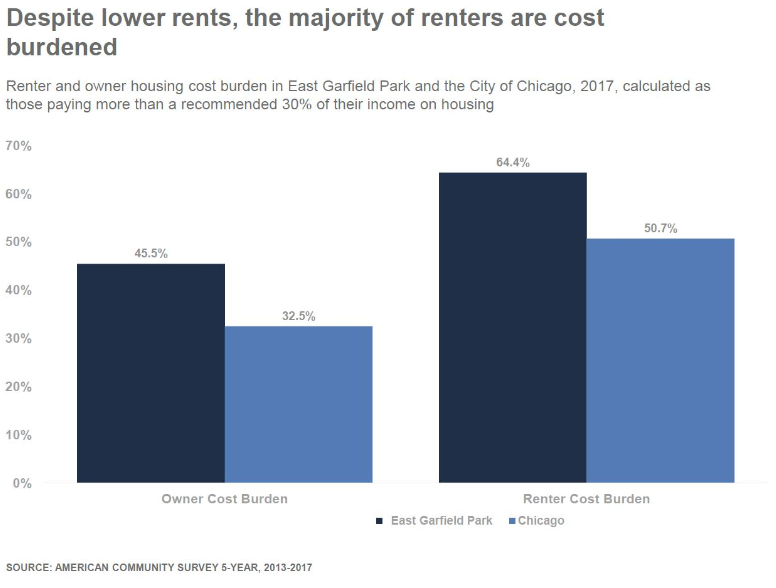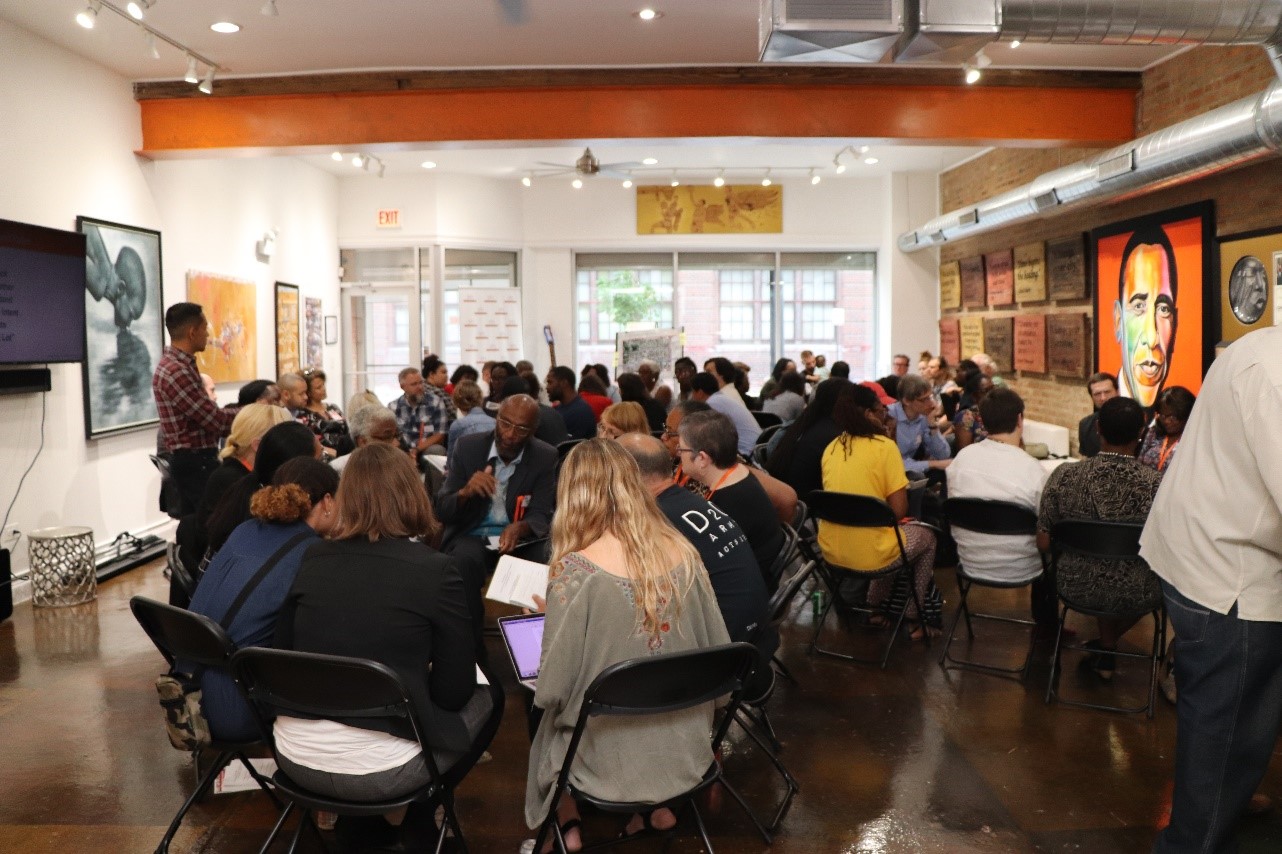
Liz Granger, Metropolitan Planning Council
East Garfield Park residents share what they see as the most pressing issues facing their neighborhood.
 By Michael Wieczorek, 2019 King W. Harris Summer Intern; Edited by: Juan Sebastian Arias, Manager
By Michael Wieczorek, 2019 King W. Harris Summer Intern; Edited by: Juan Sebastian Arias, Manager - August 21, 2019
Tweet this
To hear longtime residents tell it, understanding East Garfield Park today begins with a look back to 1968. Race riots sparked by the assassination of Dr. Martin Luther King Jr. occurred in the neighborhood that year. Decades later, the neighborhood still bears the scars of those events, and many businesses lost in those days never returned. Additionally, public policies that exacerbated inequality and enforced racial segregation worked in tandem with these events to suppress investment in the neighborhood. School closings and ongoing violence have continued to harm the community in recent years. Nonetheless, the East Garfield Park boasts significant assets such as excellent access to CTA rail stations, a close proximity to downtown, the expansive Garfield Park, the world-class Garfield Park Conservatory, and dedicated residents.
To hear longtime residents tell it, understanding East Garfield Park today begins with a look back to 1968.
Today, changing economic and cultural landscapes have led to new investment arriving in East Garfield Park. There are several new developments in the area, including a food business incubator called the Hatchery, a community orchard named the Eco Orchard, the newly built selective-enrollment Westinghouse High School, and a planned environmentally sustainable affordable housing development called Garfield Green.
While many residents acknowledge investment is needed to bring economic vitality to East Garfield Park, some also report seeing the beginning signs of gentrification in the area and are concerned about displacement. “I’m seeing some new professionals moving into the neighborhood. It is great to see that, and I welcome it. That is needed, and I like the diversity. But I just don’t want to get pushed out, or see other longtime residents get pushed out,” said Ruby Taylor, a longtime resident and Executive Director of the nonprofit Taproots.
Coming Together to Preserve Affordability
Together with our partners in East Garfield Park, MPC is piloting a community-driven planning process to work with residents in addressing this very concern: How can the community have new development and investment, while also ensuring that current residents do not get displaced? As part of this Preserving Affordability Together (PAT) pilot, MPC is partnering with local community groups, like the Garfield Park Community Council (GPCC), as well as the Institute for Housing Studies at DePaul University. Together with community residents and leaders, we are facilitating a process that includes data analysis of current housing conditions and trends, robust community engagement to identify the most pressing issues, and partnering with residents to draft an affordability preservation plan that outlines community-driven solutions for various stakeholders to take.
Following several months of community engagement, MPC hosted the first public Preserving Affordability Together community meeting at 345 Art Gallery on July 23rd. A diverse group of over 50 community members turned out for the meeting, and approximately 31% of attendees were longtime residents of 10 years or more.
First, We Began with Data
Geoff Smith, Executive Director of the Institute for Housing Studies (IHS) at DePaul University, began the meeting with a look at what the data shows about development in East Garfield Park. He highlighted early warning signs of increasing displacement pressures in much of the area. This pressure is the product of rapidly rising property values, which appear to be driven mostly by investors and speculation. Although rents have remained stable and low relative to the city, rising property values are concerning for many residents as an indicator of potential future affordability challenges. For example, although values are still low relative to the city as a whole, median sales prices for a 1-4 unit building rose from under $40,000 in 2012 to $160,000 in 2018. Most renters in the neighborhood are also cost burdened, meaning they spend more than 30 percent of their income on housing.

Source: Institute of Housing Studies at DePaul University
Geoff also noted that while 77% of residents are renters, converting neighborhood renters to homeowners might be difficult, as only 23% of renters could afford a mortgage based on income alone. One opportunity for the neighborhood is that there are many city-owned vacant lots, and developing these lots could reduce pressure on existing housing stock or to advance other community development goals identified by residents.
Finally, despite rapidly rising property values, the neighborhood’s demographic makeup remains stable. The White population increased slightly, but the neighborhood remains majority African American. Additionally, the number of low income households and high income households also increased slightly; however, the area remains primarily lower income.

Source: Institute for Housing Studies at DePaul University
After the presentation, Geraldine Blair, a longtime resident, spoke about the importance of the community coming together to address these development issues while bridging cultural differences between Black and White residents.
Co-Creating Solutions
Next, the meeting broke into small groups to discuss residents’ most pressing hopes and concerns for new development, as well as brainstorm action steps needed to ensure development benefits current residents. Through an informal poll conducted at the end of the meeting, participants were asked which of the various issues raised in their discussions were the most pressing for the community. Four issues garnered the most votes: developing local businesses and improving access to capital, improving access to homeownership, preventing displacement, and preserving affordability for existing residents.

Liz Granger, Metropolitan Planning Council
Members of the East Garfield Park community discuss their concerns and hopes for new development in the area.
This meeting is the first in a series that MPC will conduct in partnership with community organizations and leaders. In the coming months, we will work closely with community leaders to co-create a collectively owned action plan. Please contact jsarias@metroplanning.org if you are interested in joining this effort to preserve affordability in East Garfield Park.

Members of the East Garfield Park community participate in small group discussions.
Michael Wieczorek is the 2019 King W. Harris Summer Intern at the Metropolitan Planning Council, and he will be graduating with a Master of Public Affairs from the University of Wisconsin-Madison in Spring 2020.